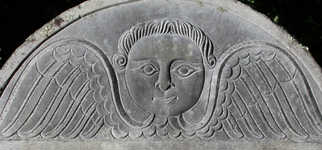Colonial rock-slab gravestonesEvery colonial New England town has at least one historic burying ground with waist-high gravestones made of gray slate, white marble, or red sandstone. These slabs, few more than 5 cm thick, were set in the 200-year period starting in the 1640s and are related mainly by their shape but also by a continuity of design.

The folk art of gravestone carving developed simultaneously in both Europe and the colonies a half-century after the Puritan migration of 1620-1630. The earliest grave markers were probably wood and none survive. A stone dated 1644 is the oldest known marker. Gravestone historians (Duval and Rigby, 1978) suggest that decorating the stone tops began in 1674 with an intaglio-carved winged skull found in Charlestown's Phipps Street burying ground. This Puritan symbol for death persisted as a common design until after the design revolution of 1800. Winged cherubs or "soul effigies" evolved from the skull within 20 years and the great preponderance of colonial slab stones carved before 1800 are decorated with faces - winged and without, symmetrical or not.
Branches or full trees arching over some kind of vessel began appearing as intaglio carving on some slate markers in 1779 and by 1810 had completely supplanted winged skulls and faces. Soon after that, pure white slabs of sawn marble from quarries in New Hampshire and Vermont began to replace both sandstone and slate. Marble carvers tried to use the same designs but the coarse rock grain did not hold the fine detail available in slate so new designs evolved. Unbeknownst to these carvers, the marble is a carbonate rock that melts away in acid rain. Many of the older marble slab markers have lost all their carving. Carbonate also supports lush growths of black lichen. Colonial inscriptions are as fascinating as the pictoral designs. Letters were different, spelling was decided by the carvers, and many stones have verses cut below the names and dates. |